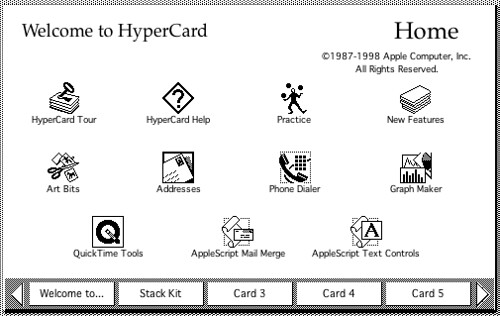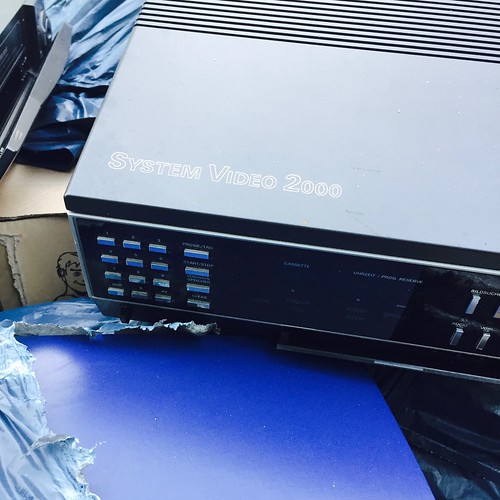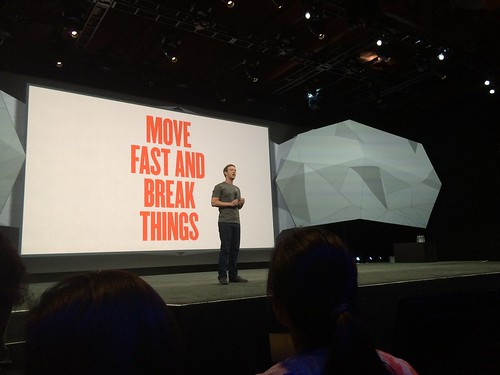12 minutes estimated reading time
I was sat thinking about a client project the other day. I was using Miro as a way to articulate my thoughts into something that the creatives could work with. As I stared off at a Post-It note on my wall that made up part of the prototype the idea that the tools are changing sailed in and sat at the front of my thoughts. I became deeply uncomfortable.
At a conscious level I know that technology and the tools that I use based on it are changing all the time. But what made me more uncomfortable was a deeper shift in the model of how the tools interacted with me and where the control sat. Sometimes it feels as if we longer use them, instead they use us. To what end has never been clearly articulated.
This quote from my first agency boss describes the nascent online landscape of the late 1990s:
After 50 years of radio and TV pushing marketing messages at people, it took technology to turn it around so that people pull in the information they want. Today’s new consumer has a cultural comfort with interactivity that just keeps building on itself, and it’s all because the technology is finally where it needs to be to let them do it.
Larry Weber on the old Weber Group website
I just couldn’t imagine the same thing being said about the experience of most netizens in our social platform dominated world today. The tools are changing, they now use us more than we use them.
I was particularly struck by this statement quoted in a BBC article and attributed to Thomas Bangalter
“Daft Punk was a project that blurred the line between reality and fiction with these robot characters. It was a very important point for me and Guy-Man[uel] to not spoil the narrative while it was happening.
“Now the story has ended, it felt interesting to reveal part of the creative process that is very much human-based and not algorithmic of any sort.”
That was, he says, Daft Punk’s central thesis: That the line between humanity and technology should remain absolute.
“It was an exploration, I would say, starting with the machines and going away from them. I love technology as a tool [but] I’m somehow terrified of the nature of the relationship between the machines and ourselves.”
Life after Daft Punk: Thomas Bangalter on ballet, AI and ditching the helmet by Mark Savage – BBC (April 4, 2023
Why tools are changing
The Apple Mac: a bicycle for the mind
A couple of my friends had home computers that were used as glorified games consoles. There was little technological value in playing Daley Thompson’s Decathlon or Frogger using the rubbery keyboard of a Sinclair ZX Spectrum. My school had a computer lab with three seldom used BBC microcomputers and I had one lesson on using Excel during my time in school. This all meant that I really came to computing in the late 1980s and early 1990s. I was a self taught Mac user. From someone who was used to hand writing or typing documents, cut-and-paste was a radical new way of creating a document.
Having my own Mac and printer helped me get through my degree relatively stress free compared to my peers who largely relied on the University’s computer and printing services facilities.
Over the time I have used computing, I’ve noticed that technology tools are changing and not for the better. Computers were seen to be personally empowering and enabling. This age of computing is encapsulated by a phrase attributed to Steve Jobs about the Mac being ‘a bicycle for the mind‘. Steve Jobs also used the analogy of a computing appliance and used both Cuisinart and Sony product philosophies as exemplars for the Apple II and Mac.
In many respect, this was similar to the vision that Stewart Brand had for the ‘back to the land’ hippie movement bible The Whole Earth catalog. The subtitle of the catalog was ‘Access to Tools’. The tools in question were an assortment of recommendations including books, maps, garden implements, specialised clothing, woodworking tools, forestry gear, tents, welding equipment, professional journals, early synthesizers, and personal computers.
Mother of All Demos
Throughout his life Brand has had a knack of being at the right place and at the right time. Including help facilitate Doug Engelbart’s ‘Mother of All Demos‘ – a public demonstration of prototype technologies that mapped out our digital age. Being in the audience for the Mother of All Demos must have been mind-blowing at the time. For an audience that would have found computer terminals transformative, there would have been a realisation that their tools are changing right in front of their eyes.
Cuisinart
The rounded edges and corners of the Apple II’s plastic case was inspired by Cuisinart, as was the Mac Classic’s ‘sit up and beg‘ stance. The idea that the the Mac was a ‘computing appliance’; something that just worked. For IT professionals of a certain age who had invested in Microsoft skills, this was mistaken for the Mac being a ‘toy’.
Before the web, this led to a religious type split. I have been a proud Mac user since 1989, which gives you an idea on where I sat. The IT professionals did not believe in personal user empowerment, but they would also struggle with the way tools are changing now as well. The thinking of these IT professionals can be seen in the clunky experience of using SAP enterprise software today.
The overlooked HyperCard
Some of the tools were brilliant ideas but didn’t get widespread adoption. My personal favourite of software in this category would be Apple’s HyperCard. HyperCard was a framework that allowed you to build processes from an address book or digital brochures to mind-blowing experiences and even running factories.
For example, Northwest Airlines managed their entire plane maintenance management programme using HyperCard. Nabisco ran at least one factory using HyperCard as an enterprise resource planning platform.
HyperCard was ‘No Code Tools‘ before the founders of AirTable or Zoho Creator were even born.
Danny Goodman who wrote a lot of the guides to HyperCard, went on to write some of the best books for programming assorted web and mobile technologies from JavaScript to iOS development.
This empowerment extended to many web technologies and web services. Email, forums and chat apps radically changed business and personal networks. It was now easier to access information and expertise. The late 1990s and email saw increased worker collaboration across offices and departments. You saw services like Yahoo! Pipes provided to ‘power-user’ consumer netizens during the Web 2.0 era. RSS newsreaders like Newsblur do a similar job, as do social bookmarking services like pinboard.in.
Modal interfaces and software buttons
When electronic products first moved into the home they had mechanical buttons. Buttons limited functionality, but allowed for the creation of highly intuitive products. Buttons have since been proven to be faster and safer to use automotive applications than touch screens. The use of touch screens being driven as by the car manufacturers marketing department. Logic controls were buttons connected to servos that provided a slimmer finish, a more sophisticated looking product.
Depending on the device they also allowed for the use of software.
But sophistication gave way to confusion as buttons often had to do multiple jobs and use a modal interface. I spent a good deal of my childhood programming my parents video recorders and setting the time on their digital watches and clocks in the home and the car.
Modal interfaces have their place. During my time as a student I worked for MBNA in customer service roles. The modal interface of the CardPac software allowed me to move around a customer record much faster than a point and click ‘windows type’ application. This was particularly important handling stressed customers who have been waiting to speak to a customer services rep in a phone queue.
I would switch into edit mode and quickly tab through fields of data faster than scrolling down and hunting and pecking with a mouse and cursor.
It’s not so much fun if you make one error programming a mid-1980s video cassette recorder and have to go cycle through the rest of the process to go back to the beginning and start again.
You also started to see software defined buttons. This appeared on machine tools and music instruments first. If there was ‘Mac like moment’ for software defined switches, it was the launch of the first commercially successful digital synthesiser: the Yamaha DX-7.
The Yamaha DX7 was so powerful, yet challenging to use – that a veritable cottage industry of books and tutorial videos like the one above. One of the most prominent manual writers was Lorenz Rychner, who wrote guides for various Yamaha electronic instruments as well as later Casio, Kawai, Korg and Roland instruments that was inspired by the Yamaha DX7. Eventually when personal computers became used in music production, Yamaha DX7 editing software appeared as well.
Getting these electronic instruments to work saw a new artist credit appear on albums and singles; that of MIDI programmer. In the 1980s, the audio tools are changing, but experts are required to get the most out of them due to software defined buttons. Apple took this to its natural extreme with a MacBook Pro model that replaced function keys with a touch screen that changes controls based on what software programme is being used at a given time.
Pictures under glass
Technology allowed the entire display surface to become software defined buttons, directly with your fingers. This robbed people of the tactic feedback of a button, knob or lever to create a phenomenon of ‘pictures under glass‘. This changes our relationship between our tools and how we interact with them. It also opened up new ways of interaction.
Swiping and gestures
Korean smartphone manufacturer managed to reduce the kind of gesture tracking that was previously in living rooms with Sony EyeToy series of devices controlling a Sony Playstation of Microsoft Kinect into a smartphone handset.
Pantech’s Vega LTE smartphone allowed control at a distance. This was based on technology from eyeSight to do gesture controls.
Within applications, dating app Tinder created gestures that became ‘common language‘ – to swipe left as in reject an option. But the very gesture of swiping left was part of gamification as the tools are changing from working for us, to us working for them. They are no longer tools of personal liberation in terms of ideas and thinking.
Digital drugs
Captology to captured users
To talk about how tools changed and became items of personal enslavement one has to back to the late 1990s. B.J. Fogg is a combination of media theorist and technologist with a doctorate in communications and heading a behavioural design lab at Stanford University.
The insight that B.J. Fogg had was that with the right design cues, computers could become ‘charismatic’ in nature. They could manipulate behaviour. Professor Fogg converted his doctorate paper into a new discipline that he called ‘captology‘ ( from computers as persuasive techologies). By 2003, Fogg had realised that some of the methods had negative impacts on users. He flagged ethical use to his own students and in his book Persuasive Technology: Using Computers to Change What We Think and Do.
Unfortunately, a number of Fogg’s students and readers took these unethical tactics into Silicon Valley businesses and used them as ‘growth hacks’ for brands as diverse as Tinder (swipe right) and Robinhood the stock trading app that gamified transactions. This was the dark side of ‘move fast and break things’ mentality prevalent in Silicon Valley at the time.
Other’s like Fogg’s student Tristan Harris saw what was happening and were horrified. Harris went on to co-found The Center for Humane Technology – an organisation raising awareness of the problems and holding the organisations to account.
Addiction
What was then termed internet addiction or video gaming addiction was by recognised as an issue by both the World Health Organisation (WHO) and the Chinese government. As far back as 2006, China estimated the number of addicts in its country as numbering 2 million children and young adults.
Psychoactive tools
Modern technology didn’t bring a distortion of reality on their own. Regulation and media owners have a lot to do with it. The origin of the modern ‘filter bubble’ was said to be syndicated talk radio host Rush Limbaugh as media regulations were relaxed. This allowed media eco-systems to be created that catered to left wing or right wing views. There was no longer a common view, which people could hold different opinions over, but ‘the truth’ and ‘alternative facts’
“You’re saying it’s a falsehood, and Sean Spicer, our press secretary, gave alternative facts,”
Kellyanne Conway quoted in The Atlantic magazine
A combination of societal isolation, reductive algorithmic models, bad actors and dark pattern designs leave users more vulnerable in the online world. Machine learning and internet content allow for the creation of an overwhelming amount of content.
Whole worlds can be created. This means that there is no social glue of common experiences. There is no consensus and technology enables the bar bell.
Being boring
So enough about digital drugs. Let’s back to something more boring. In the appropriately titled essay The Future is Boring by Eliane Glaser published by Monocle in its Monocle Companion Volume 2: 50 essays for a brighter future; the author discusses the pointless rituals of techno-capitalism. The reason for these pointless rituals is often that the tools are changing, providing useless digitally mediated services and access that is ultimately unfulfilling in both form and function.



